
President's Message: Leadership and Governance Plans for the Next Year

Marian L. Fitzgibbon, PhD, SBM President
I started my one-year term as the 37th president of the Society of Behavioral Medicine (SBM) about two months ago at our 2015 Annual Meeting. I'm honored to be holding the position, and I'm excited about what we can accomplish together in the next year. Chief among my aims are a new leadership development institute, continued SBM governance work, continued engagement of policymakers, forging stronger ties with other professional organizations, and a fabulous 2016 Annual Meeting.
Presidential Plans
As president, I intend to create a leadership institute primarily for mid-career members. In academia and as a professional society, we spend much time nurturing and mentoring students and early-career individuals. We similarly take time to celebrate the research and achievements of our more seasoned colleagues. Mid-career people tend to get less attention and it is my hope that an SBM leadership institute could address this critical gap, focusing on issues such as mapping career trajectories; balancing research, teaching, clinical, and service responsibilities; choosing academic versus industry versus other career opportunities as your career advances; development of leadership skills; and successful negotiating. These are some of the topics that we have begun to identify, and we are looking forward to crafting a comprehensive program that will serve the needs of our members.
I have formed a task force that will begin to identify how to best address the content of this type of program as well as both short- and long-term goals. The initial goal will be to pilot a first version of the program at next year's annual meeting.
Continued Governance Work
During my year as SBM president, the society will also continue the governance work started by immediate SBM Past-President Lisa M. Klesges, PhD. A year ago, Dr. Klesges convened a Governance Working Group and tasked it with making recommendations for increasing societal efficiency, improving coordination and communication among SBM bodies, and strengthening connections with members. Such recommendations were presented to the SBM Board in April. Refining those recommendations and implementing them will be a priority for me throughout 2015-16.
The group's recommendations overall focus on clarifying and strengthening board member roles and achieving alignment with SBM's four specific strategic directions.Annual Meeting Success
Last but not least, I would like to highlight the success of the 2015 Annual Meeting in San Antonio that was attributable to the vision and hard work of Dr. Klesges, 2015 Program Chair Lila J. Finney Rutten, PhD, and 2015 Program Committee Co-Chair Kathleen Wolin, ScD. Special thanks to each of them and to the full 2015 Program Committee. Meeting attendance was strong, keynotes were inspiring, and networking was at its best.
SBM's 2015 Achievement Awards were also presented at the Annual Meeting. My sincerest congratulations to all award winners. Two of the awards come with the honor of delivering a master lecture at the following Annual Meeting. I hope you'll keep an eye out at SBM 2016 for presentations from Colleen M. McBride, PhD, recipient of the Distinguished Scientist Award, and Michael G. Goldstein, MD, recipient of the Jessie Gruman Award for Health Engagement.
Planning for the 2016 meeting has begun. The theme will be "Behavioral Medicine at a Crossroads: 21st Century Challenges and Solutions." We have already started to identify outstanding speakers and want our membership to come away from the 2016 meeting with enhanced knowledge, skills, and renewed energy as to the incredible impact of behavior and behavioral medicine on health and health outcomes.
The 2016 meeting will be here before we know it; with it will come the end of my presidency. I plan to make the most of my time before then. I hope you'll help me by sharing any comments, concerns, or questions. SBM is nothing without its members, and your input is valued above all else.
Thank you for reading, and thank you for your commitment to SBM.

Marian L. Fitzgibbon, PhD
President
Society of Behavioral Medicine
Board Notes: Plans to Partner with Industry, Improve Society Governance
Over the past year—and especially during its April meeting—the Society of Behavioral Medicine (SBM) Board of Directors focused on two initiatives: developing partnerships with industry and adopting new societal governance practices.
Developing Partnerships with Industry
A Revenue Enhancement Working Group convened by SBM immediate Past-President Lisa M. Klesges, PhD, has been working on a business plan for an SBM consulting enterprise that would connect SBM members with tech industry leaders in part to make sure digital health interventions are truly evidence-based. Tech developers, patient consumers, SBM members, and the society itself could all benefit.
Such a consulting entity is far from finalized. During the April meeting of SBM's Board of Directors, board members discussed the idea broadly. They defined "industry" to include not only technology-related ventures but also health systems, pharma, and more. They also identified core values that should guide SBM as it establishes industry partnerships. For instance, the process should be transparent, science/research must be imbedded into any resulting products, SBM should refrain from endorsing products, and patients (rather than SBM or industry) should be the primary beneficiaries of any partnerships.
The board further outlined benefits that might accrue from such partnerships (e.g., translation of research into practice; increased visibility of SBM and its members; showing relevance of behavioral medicine; and increased revenue for SBM, members, and industry). Pitfalls were outlined as well (e.g., potential to stray from SBM mission, development and legal costs, conflicts of interest).
The board approved further exploration of the consulting enterprise proposal, perhaps with the assistance of a prestigious business school.
Adopting New Governance Practices
A Governance Working Group, also convened by Dr. Klesges, developed recommendations to increase societal efficiency, improve coordination, and strengthen connections with members. Working group leader Sara Knight, PhD, delivered those recommendations to the board during its April meeting.
Overall, the recommendations focus on (1) clarifying and strengthening board member roles, particularly those of member delegates, and (2) achieving alignment with SBM's four specific strategic directions. Alignment could entail SBM councils/committees developing year-long agendas based, in part, on the strategic directions; presidents seeking board input in the development of presidential initiatives; and the board regularly assessing progress related to the strategic directions.
Other Board Actions
During the April meeting, board members also voted to
- renew their commitment to offering continuing education credits to Annual Meeting attendees;
- and accept the independent audit of the society's finances.

2014 Annual Report Shows SBM's Year in One Infographic
What did the Society of Behavioral Medicine (SBM) accomplish in 2014? What did your membership dues pay for? It's all in the 2014 Annual Report infographic.
Report highlights include:
- SBM had 2,209 members.
- SIGs shared 140 job openings.
- A new Digital Health Council and SBMConnect issues blog were created.
- Leaders had 14 visits with health policy aides on Capitol Hill.
- SBM released three policy briefs.
Congratulations to the Recipients of SBM's 2015 Achievement Awards
The Society of Behavioral Medicine (SBM) extends a warm congratulations to the following recipients of the society's 2015 achievement awards. Recipients are pictured below with SBM 2014-15 President Lisa M. Klesges, PhD. Recipients formally received their awards from Dr. Klesges on April 22, 2015, during SBM's 36th Annual Meeting & Scientific Sessions at the Marriott Rivercenter in San Antonio, TX.
SBM additionally congratulates new 2015 society fellows, who were also honored by Dr. Klesges during the Annual Meeting and are pictured with her below.
SBM would like to recognize the recipients of 2015 Special Interest Group (SIG) Awards as well. Recipients were honored during individual SIG meetings at the Annual Meeting, and their names are listed below.
Alere Research to Practice Award
Herbert H. Severson, PhD
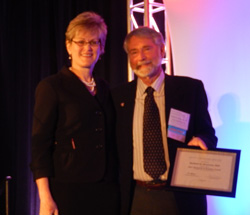
C. Tracy Orleans Distinguished Service Award
Claudio R. Nigg, PhD; Sherry L. Pagoto, PhD; Dawn K. Wilson, PhD; Laura L. Hayman, RN, PhD, FAAN; and Lila J. Finney Rutten, PhD, MPH

Distinguished Research Mentor Award
Lori Pbert, PhD
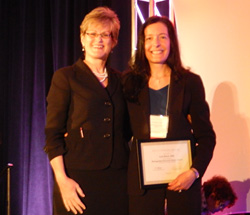
Distinguished Scientist Award
Colleen M. McBride, PhD
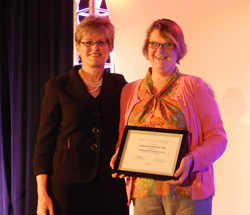
Distinguished Student Excellence in Research Award
Scherezade K. Mama, DrPH; and Danielle E. Schoffman

Distinguished Student Travel Scholarship
Melissa M. Crane, MA; Cassandra Lowe, MSc; and Sara N. Edmond, MA

Early Career Investigator Award
George M. Slavich, PhD
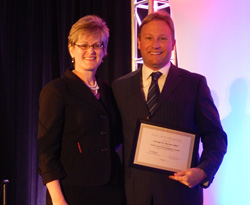
Jessie Gruman Award for Health Engagement
Michael G. Goldstein, MD
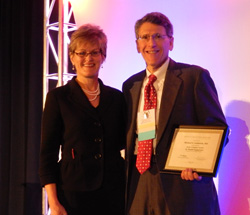
Outstanding Dissertation Award
Jessica K. Pepper, PhD
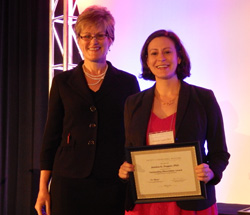
New 2015 Fellows
Jennifer L. Huberty, PhD; Youngmee Kim, PhD; and Alexander J. Rothman, PhD
(Not pictured: John P. Allegrante, PhD; and Joan S. Tucker, PhD)

Special Interest Group (SIG) Awards
Aging SIG Local Innovator Award
Texercise
Aging SIG Student Award
Tiffany A. Bullard
Cancer SIG Outstanding Student Abstract Award
Daisy Le, MPH, MA
Cancer SIG SIGGIE Senior Investigator Award
Barbara L. Andersen, PhD
Child and Family Health SIG Award for Outstanding Research in Child and Family Health
Sharon D. Horner, PhD, RN, FAAN
Child and Family Health SIG Special Recognition for Service to Child and Family Health
Dianne S. Ward, EdD
Diabetes SIG Early Career Travel Award
Georica Gholson, PhD; and Lyndsay A. Nelson, PhD
Ethnic Minority and Multicultural Health SIG Trainee Award for Outstanding Oral Abstract Submission
Teresa M. Smith, PhD, MS
Ethnic Minority and Multicultural Health SIG Early Career Award for Outstanding Oral Abstract Submission
Laura A. Dwyer, PhD; Grant W. Farmer, PhD, MPH, MA; and Aasim I. Padela, MD, MSc, FACEP
Ethnic Minority and Multicultural Health SIG Mentoring Award for Dedication to Training and Mentoring of the Next Generation of Health Equity and Disparities Research Scientists
Cathy D. Meade, PhD, RN, FAAN
Evidence-Based Behavioral Medicine SIG Outstanding Student/Trainee Award in Evidence-Based Behavioral Medicine
Bradley James Kendall, MS, CSCS
Health Decision Making SIG Outstanding Trainee Abstract Award in Health Decision Making
Lisa Carter-Harris, PhD, APRN, NP-C
Military and Veterans' Health SIG Patricia H. Rosenberger Award for Outstanding Student/Fellow Abstract
Megan A. McVay, PhD
Physical Activity SIG Local Innovator Award
Estrella Hernandez
Physical Activity SIG Outstanding Student Abstract Award
Desmond McEwan, MSc
Student SIG Student Abstract Award
Stephen Ghazikhanian; and Jennifer L. Moss, MSPH
Student SIG Early Career Mentor Award
L. Alison Phillips, PhD
Student SIG Senior Mentor Award
Vanessa L. Malcarne, PhD
2015 Annual Meeting Stays True to National Prevention Strategy Theme
Lila J. Finney Rutten, PhD, MPH, Program Committee chair; and Kathleen Wolin, ScD, Program Committee co-chair
The stage was set for the Society of Behavioral Medicine's (SBM) 2015 Annual Meeting & Scientific Sessions with a thoughtful and inspiring opening keynote delivered by Minnesota Commissioner of Health Edward Ehlinger, PhD. Dr. Ehliger's keynote, with its attention to social and environmental determinants of health and its unwavering focus on health equity, brought into focus the fundamental components of the National Prevention Strategy, which served as the guiding framework for the 2015 meeting. The National Prevention Strategy identifies four strategic directions and seven targeted priorities for improving population health with clear relevance to the scientific efforts of the multidisciplinary membership of SBM. The strategic directions include creating and sustaining healthy and safe community environments that promote health and prevent disease; providing accessible and integrated clinical and community preventive services; providing the necessary tools and resources to support communities of empowered people; and improving health and quality of life for all through elimination of health disparities.
Throughout the meeting, the themes adopted from the strategic directions of the National Prevention Strategy resounded. Carol Naughton, JD, delivered a keynote describing the transformative impact of creating healthy and safe community environments. She spoke of empowering people and eliminating health disparities in Purpose Built Communities in Atlanta, GA. Raymond Baxter, PhD, in his stimulating keynote, described a vision for total health drawing on the groundbreaking efforts at Kaiser Permanente to integrate clinical and community preventive services, and to care for populations and communities. Judith Ockene, PhD, in her eloquent master lecture, also spoke to the evolving landscape in health care with a focus on the impact of the physician-patient relationship and integration of community and clinical care. Trissa Torres, PhD, continued this theme in her enthusiastic master lecture on movement toward greater clinical commitment to population health with payment reform; she offered inspiring examples of successful clinical-community partnerships. The closing keynote panel, chaired by Amelie Ramirez, PhD, highlighted the crucial role of communities in improving population health. The panel featured local speakers from community organizations committed to reducing the burden of obesity. Key priorities laid out in the National Prevention Strategy, including tobacco-free living, healthy eating, active living, and sexual health were integrated with cross-cutting themes identified in SBM's strategic plan throughout the program. For example, Bradford Hesse, PhD, gave a compelling master lecture on the role of big data in supporting population health research and improvement, offering intriguing opportunities for exploring novel methodologies in behavioral medicine. Margarita Lightfoot, PhD, in her energetic master lecture, described the emerging evidence base for use of technology to deliver behavior change interventions to prevent risky sexual behavior.
In her presidential keynote, Lisa Klesges, PhD, drew upon the ancient Greek conceptualizations of time—chronos and kairos—to fluently describe our collective journey in chronological time: chronos, to build an evidence base in behavioral medicine and to underscore the opportune moment in time, and kairos, before us as a professional society to have an impact on population health. The rigorous and significant science presented throughout the meeting in paper and poster sessions, symposia, roundtables, and seminars was worthy testimony to the progression of our professional society toward a readiness for the unparalleled opportunities to contribute meaningfully toward efforts to improve population health. As always, the networking offered at the meeting meant our members engaged in rigorous debate and asked thought-provoking questions of each other while meeting new attendees and sponsors. Both the accomplishments and opportunities for SBM were captured persuasively in Dr. Ehlinger's friendly "revision" to the SBM mission statement. He suggested it include greater recognition of the environmental, social, and political forces that shape health, and that it also include a specific aim toward health equity: "Dedicated to promoting the study of the interactions of behavior with biology, the environment, and the socioeconomic and political context, and then applying that knowledge to advance health equity and improve the health and well-being of individuals, families, communities, and populations."
The broad vision of this proposed amendment to the society's mission statement and the momentum of the 2015 Annual Meeting has carried over into planning for our 2016 Annual Meeting, to be held March 30 to April 2 in Washington, DC. The 2016 meeting, themed "Behavioral Medicine at a Crossroads: 21st Century Challenges and Solutions," will focus on behavioral medicine and behavioral health research to keep our field at the forefront of efforts to improve population health. The Program Committee has received excellent suggestions from the membership for content and is looking forward to the symposia, paper, and poster submissions to showcase SBM as a thought leader in this space.

ETCD Council Thanks Fellows Who Volunteered at the 2015 Annual Meeting
The Education, Training, and Career Development Council (ETCD) would like to thank the following Society of Behavioral Medicine (SBM) fellows who volunteered their time during the 2015 SBM Annual Meeting & Scientific Session in San Antonio, TX.
Meet the Professors Social Networking Event Volunteer Fellows
Cheryl L. Albright, PhD, MPH
Phillip J. Brantley, PhD
Alan M. Delamater, PhD
Thomas K. Houston, MD, MPH, FACMI
Robert D. Kerns, PhD
Jean L. Kristeller, PhD
Kevin S. Masters, PhD
Poster Mentoring Program Volunteer Fellows
Cheryl L. Albright, PhD, MPH
Linda Ciofu Bauman, PhD, RN, FAAN
Laura M. Bogart, PhD
Angela D. Bryan, PhD
Karen J. Calfas, PhD
Patricia M. Dubbert, PhD
Charles F. Emery, PhD
Marian L. Fitzgibbon, PhD
Marc D. Gellman, PhD
Jeffrey L. Goodie, PhD, ABPP
Thomas P. Guck, PhD
Laura L. Hayman, MSN, PhD, FAAN
Vicki S. Helgeson, PhD
Rodger S. Kessler, PhD, ABPP
Rebecca E. Lee, PhD
Mark D. Litt, PhD
Sharon L. Manne, PhD
Shannon L. Mihalko, PhD
Karen M. Mustian, PhD
Claudio R. Nigg, PhD
Judith K. Ockene, PhD, Med, MA
Lori Pbert, PhD
Donald B. Penzien, PhD
Bernardine M. Pinto, PhD
Jennifer L. Steel, PhD
Jerry M. Suls, PhD
Karen L. Syrjala, PhD
Peter A. Vanable, PhD
Corrine I. Voils, PhD
Dawn K. Wilson, PhD
ETCD Council Offering Career Development Opportunities All Year Round
Nicole Zarrett, PhD, Education, Training, and Career Development Council chair
The 2015 SBM Annual Meeting was an exciting one for the Society of Behavioral Medicine's (SBM) Education, Training, and Career Development (ETCD) Council. Each year we offer sessions for members at all stages of their careers. Below are some program highlights. We have also included information about our consultation program, a resource we offer throughout the year.
Meet the Professors: SBM Fellow Office Hours for Social Networking
This was the first year that ETCD offered a session titled, Meet the Professors: SBM Fellow Office Hours for Social Networking. The event featured invited SBM fellows from each SIG who agreed to serve as mentors (professors). The session began with a presentation by the event moderators on networking techniques and a demonstration of those techniques in action. Following the presentation, attendees were organized into discussion groups with their choice mentor(s) and given the opportunity to identify and practice skills needed to build a social network, develop ideas for collaborations with others in their field, and obtain career advice. The informal environment lead to an afternoon full of invigorating conversation with attendees reluctant to leave at the completion of the session. More than 50 people attended the event which drew everyone from graduate students to senior faculty members. Given the success of the event, the ETCD Council hopes to offer similar sessions at future annual meetings.
Poster Mentoring Program
The Poster Mentoring Program enjoyed its fourth year during the 2015 meeting, and offered SBM student/trainee members the chance to interact one-on-one with senior SBM members. Selected student/trainee members (picked through a random drawing) were paired with SBM fellows within similar fields of research. The fellows attended the student/trainees poster presentations to provide valuable feedback on their research and to discuss future directions and/or career goals. This year's program participants reported receiving helpful feedback on research design and advice for completing dissertations. They also feel the program is beneficial, particularly for students who may not get a lot of input from their own (local) mentors about their posters.
"Honestly, I have nothing but positive feedback for the poster mentoring session!" said Jennifer Kim Bernat, PhD, MS, speaking of her time spent with SBM Fellow Dawn K. Wilson, PhD. Wilson encouraged her to publish her work and gave suggestions to strengthen the literature review and discussion.
"I'm currently writing up the paper, and I hope to submit it in the next month," Bernat said. "Thanks again for the opportunity, and I hope you continue this program in the future."
Career Development Panels
The ETCD Council offered two panel discussions at the 2015 Annual Meeting. The first panel (Careers in Behavioral Medicine: Teaching, Training, and Coaching Professionals in Health Care) focused on the opportunities and challenges found in behavioral medicine careers that include heath care provider education. The second panel (Graduate Student Research Panel Discussion) provided students with an overview of common issues that emerge with student/faculty communication, scope of thesis/dissertation topics, and networking, with questions from attendees driving the discussion. Both panels were well attended and the council plans to offer similar sessions in the future.
Consultation Program
Along with the education, training and career development opportunities offered at the Annual Meeting, SBM offers a Web-based Consultation Program which provides members with year-round electronic access to experts in various behavioral medicine areas. Prospective consultees can identify expert consultants on the SBM website and contact them with specific questions pertaining to scientific topic areas as well as career development issues. Whether you are a postdoc looking for advice on negotiating your first job or a full professor delving into a new area of research, your fellow SBM members may be able to provide the knowledge and guidance you need.
Members can access the program by logging into the Members Only section of the SBM website and clicking on the Consultation Program link in the Member Benefits list. Currently, consultants are available from the Cancer SIG, Child and Family Health SIG, Integrated Primary Care SIG, Obesity and Eating Disorders SIG, Physical Activity SIG, Spirituality and Health SIG, and ETCD Council.
While several individuals have graciously agreed to share their time and expertise, additional consultants are always welcome. Please contact Erica Linc at elinc@sbm.org or (414) 918-3156 to participate.
Thank You
And, finally, we would like to thank the SBM fellows who volunteered to participate in both our Meet the Professors social networking event and the Poster Mentoring Program.
Physical Activity SIG Interviews Russ Pate about U.S. National Physical Activity Plan
The Society of Behavioral Medicine's (SBM) Physical Activity SIG completed an interview with Russ Pate, PhD, a national and international leader in physical activity promotion. Read his discussion, below, of the U.S. National Physical Activity Plan.
PA SIG: We understand that you were instrumental in the development of the National Physical Activity Plan and are currently president of the National Physical Activity Plan Alliance. Can you tell us more about those initiatives?
Pate: The first U.S. National Physical Activity Plan (NPAP) was the result of a series of efforts between 2007-10, supported by a coalition of national organizational partners who were leaders in physical activity and public health. These organizational partners formed a Coordinating Committee. That committee received input from eight Sector Working Groups comprised of over 300 individuals who developed and refined the content of the NPAP. The plan was released in May 2010.
PA SIG: Can you give us an overview of the NPAP?
Pate: The plan is organized around eight societal sectors:
- business and industry;
- education;
- health care;
- mass media;
- parks, recreation, fitness, and sports;
- public health;
- transportation, land use, and community design; and
- volunteer and nonprofit.
Within these eight sectors, recommended strategies aimed at promoting physical activity are outlined. The strategies are each associated with concrete, evidence-based tactics that can be implemented by communities, organizations, agencies, and individuals to promote physical activity in target groups.
PA SIG: Can you give us an example of one of the strategies and tactics?
Pate: An example from the health care sector is the following strategy: "Make physical activity a patient vital sign that all health care providers assess and discuss with their patients." A specific tactic associated with that strategy is: "Develop a Healthcare Effectiveness and Data Information Set (HEDIS) measure for physical activity."
PA SIG: Is there a formal evaluation of the plan?
Pate: An evaluation of the plan is an essential component, identified by the NPAP Board of Directors. In 2011, an evaluation was undertaken to examine the awareness, adoption, and implementation of the plan. Our website has some great information about this evaluation and the hard work of those involved.
http://www.physicalactivityplan.org/evaluation.php
PA SIG: What happened after the plan was released in 2010?
Pate: After the plan was released in 2010, the organizing committee decided it was important to have a sustainable approach for expanding the impact of the plan, and for advocating for its recommendations. Thus, a 501c3 nonprofit organization was formed, and it is called the National Physical Activity Plan Alliance (NPAPA).
PA SIG: Tell us about your most recent meeting and ways to provide input?
Pate: In February 2015, we held the National Physical Activity Plan Congress in Washington, DC, to highlight accomplishments and obtain input to review and revise the plan. Stay tuned for a near-final draft of a revised NPAP to be circulated for public comment in mid-2015.
PA SIG: How might SBM members become more involved?
Pate: Having a National Strategic Plan that is well thought out is an important step for public health. The goal is now to promote and expand upon that plan. As mentioned above, the plan has well thought out evidence-based strategies in each of the sectors. These strategies can be examined and implemented by SBM members as they work with individuals and communities on physical activity promotion.
PA SIG: If an SBM member wanted to learn more or interact with the state liaisons, how might that happen?
Pate: SBM members who are interested in learning more about and/or becoming actively involved with the NPAPA are encouraged to consult the organization's website: www.physicalactivityplan.org. The plan is intended to be a resource for all who seek to take actions aimed at increasing physical activity levels of the U.S. population. The plan targets decision makers at every level, from elementary school principals and employer human resource directors to members of the U.S. Congress.
A SWOT Analysis for Psychology in Primary Care Settings

Douglas Tynan, PhD, ABPP, American Psychological Association, Integrated Primary Care SIG member
With the rapid changes in health care, many providers will be displaced and we will tend to try to hang on to our familiar ways of doing business. But to be successful, psychologists need to understand how the systems are changing and judge-as a profession-our strengths, weaknesses, opportunities, and threats (a SWOT analysis).
Strengths
Of all the mental health professions, psychology has one of the longest track records of working with primary care providers. More than 50 years ago, in 1964, the president of the American Academy of Pediatrics, in his presidential address, opined that every pediatrician should have a child psychologist working in his or her office. On the adult side, there has been active research and clinical literature in health psychology dating back to the 1960s. One of our great strengths is data collection. In this new era of health care with an emphasis on payment for value, which is defined as the outcomes achieved for the money spent, there is a growing emphasis on collecting data on individual patients in order to evaluate effectiveness of treatment approaches for both health and mental health conditions. Psychologists are very good at measuring health behavior, whether it is number of steps taken, or adherence to a medication regimen, or keeping a sleep diary. We have expertise in measurement that is highly valued. In addition, with the surge of questionnaires now being implemented online for patients, we also have the expertise on gathering reliable and valid data.
Another strength is the emphasis on evidence-based approaches. In the current, rapidly shifting environment, many approaches are being attempted, and it is our professional scientific rigor that will help sort out what works from what doesn't work.
Weakness
Work in primary care draws upon the basic skills of being a good psychologist. These include forming relationships with patients and health care providers, implementing evidence-based treatment in clinic settings, and adapting treatments to a primary care environment. It requires specific training on how to work on a team within a health care environment, a very different experience than that of a solo practitioner. The skills to adapt psychological interventions in primary care are currently taught late in training. Moving this earlier in graduate school curriculum could help with the supply. For psychologists in practice, there is a need to re-train in primary care skills, and those opportunities are in short supply. So while the skills and competencies have been identified (McDaniel et al. 2014), training opportunities are hard to find. For those working in primary care, their professional identity is new, and at clinic, county, state, and national levels it is important to develop connections with other primary care psychologists.
Opportunities
Under the Affordable Care Act, within health prevention services, there are mandated screenings for depression, child development milestones, domestic violence, substance abuse, and risky sexual behaviors. Under prevention services there is also counseling for obesity, smoking cessation, alcohol misuse, and HIV risk prevention. While these are mandated to be done by primary care providers and currently psychologists are not reimbursed for those services in the fee-for-service system, as we move to a system that will be paying those providers in a bundled per-member-per-month payment, it may well be possible for psychologists to provide those services. Also, in the current environment, nearly all insurance plans have mental health benefits so psychologists can bill in primary care settings. Last, as the health care system changes, physicians will be reimbursed if their patient populations do better on common measures such as blood pressure, blood glucose levels, and cholesterol levels as well as patient satisfaction. Existing research would suggest that psychological interventions can have an impact on those outcome variables. When engaging physicians in discussions of cooperation, it is helpful to remind them that the work we do often significantly impacts those measures.
Threats
A number of other professions are now working in the area of health behavior and in mental health domains. The most common new provider is the "health coach," who can range from a licensed professional (e.g. nurse, social worker) who has been through a formal university-based training program with supervised practicum experience, to someone who has completed a weekend workshop or relatively brief online training. Certificates in health coaching abound, and those with such certificates are perceived as a lower cost alternative provider. In a health care team setting, psychologists can help consult with and at times supervise health coaches and can help define which patients are appropriate for coaching and which ones need a higher level of service. Health coaches are not developed to replace psychologists; they are present to help patients target specific health-related behaviors and achieve goals. While some perceive health coaching as a threat, one may think of it as an opportunity. A clinic with health coaching is focused on behavior, and it is in that environment that psychology has an opportunity to thrive. Working with health educators and health coaches and developing consistent effective programs for health behavior change can be an opportunity for psychology, if we take it. If we don't, someone else will take it.
Overall, the future looks good, as long as we maintain our strengths, work to overcome our weaknesses, and most importantly work with the perceived threats by other providers as an opportunity to creatively lead and improve health care teams. The future is potentially very bright, but we have to be proactive and vigilant in adapting to changes in the health care system. Our best supports as we move forward are groups of psychologists who are successfully engaged in this work: For instance, our fellow members of the Integrated Primary Care SIG. As each of us deals with contracts, billing, scheduling, types of services provided, new opportunities, or new difficulties, we need to share that information in real time with our peers. We in the IPC SIG are our own best resource, so we should actively share our experiences in dealing with the threats, and leverage our strengths by collaborating on research that furthers our aims.
Reference
McDaniel, S. et al (2014) Competencies for psychology practice in primary care. American Psychologist 69, (4), 409-429 DOI: 10.1037/a0036072
Integration of Behavioral and Mental Health Providers in Primary Care: Challenges and Opportunities
Ashley D. Halle, OTD, OTR/L, University of Southern California, Integrated Primary Care SIG member
The signing of the Patient Protection and Affordable Care Act (ACA) in 2010 indicated the beginning of one of the most significant re-workings of the U.S. health care system in national history. This changing and unpredictable health care landscape can be unsettling, as it requires providers to practice in the present but with a watchful eye on the future. However, it also provides extraordinary opportunities for health care administrators and practitioners to more closely examine the benefits that result from the integration of behavioral and mental health providers in primary care.
In order to have a more holistic understanding of the issues surrounding integrated primary care and the emerging opportunities, I contacted two individuals involved in transformative primary care efforts at the University of Southern California (USC) to ask them to share their distinct perspectives. They are family medicine physician Jehni Robinson, MD, and occupational therapist Chantelle Rice, OTD, OTR/L, CDE.
Dr. Robinson is an associate professor of clinical family medicine and the vice chair of clinical affairs for the USC Keck Department of Family Medicine. She completed her residency at Harbor-UCLA Family Medicine in 2000 and spent many years designing and providing collaborative primary care services in community clinics before coming to USC.
Dr. Rice is the director of the USC Occupational Therapy Faculty Practice, a private clinic where occupational therapists deliver lifestyle-based interventions to patients with a variety of medical diagnoses and conditions. A Certified Diabetes Educator®, she works predominantly with Lifestyle Redesign® Weight Management and Diabetes Management clients.
IPC SIG: What are the behavioral/mental health needs you see in primary care practice at USC that are common or are not being adequately addressed at present?
Robinson: There is a tremendous need for mental health and behavioral health services in primary care. About one-third of the patients coming to a primary care clinic have a need such as depression or anxiety, especially in patients with chronic diseases. Mental and physical health are connected. There needs to be proactive self-management by the patient. If patients are suffering from depression and thinking, "What's the point?" it makes it hard for them to eat right, exercise, and manage their chronic illnesses.
Rice: People are probably coming in to primary care clinics with things like stress, depression, anxiety, and other mental health concerns. Those conditions are coming up in those sessions, but they're not being referred out and they're not being seen regularly to address those things specifically. They're probably addressing some of the more chronic conditions, like physical disabilities, diabetes, and hypertension, but not the mental health issues that come up with those as well.
I think that many health practitioners in these settings are not necessarily addressing habits and routines and the impact that they can have on physical and mental health and chronic disease management. This includes things like eating routines, sleep patterns, physical activity, engagement in meaningful leisure activities, and social relationships. All of those things have an impact on health, and I don't think that that's being emphasized or addressed to the extent it should in primary care settings at this time.
IPC SIG: What are some of the major obstacles to integrating behavioral/mental health providers in primary care at USC?
Robinson: The way that health care services and insurance are structured. So the fact that we have carved out mental health services makes providing those services incredibly challenging. I always tell patients, "Your head is connected to the body, and we have to address those simultaneously." But the fact you have to call the number on the back of your card to find mental health services covered by your insurance plan is not a collaborative way to practice. It would be great to have someone on site.
Another thing is that I cannot bill for mental health services. If I try to address those needs, I won't get paid for those services. We still do it; we have to do it every day. But we have billing staff that come back and say we can't bill for it, it won't go through. Even for things like obesity. This is a major problem.
Rice: Reasons we're not more integrated is we don't have a venue yet in primary care where we come together to discuss our patients with everyone collaborating in the ways we know we ideally could. But it's getting better and better. So we are creating more and more opportunities to connect and collaborate with other health professionals. I would say that we are getting to a place where [the other providers] really understand occupational therapy, and they feel just as frustrated that we can't collaborate more. To a certain extent, there are just some administrative barriers to getting to that ideal place of being co-located and having team meetings and integrated care.
IPC SIG: Based on your experiences at USC, what do you perceive as the benefits of integrating behavioral/mental health providers in future primary care efforts?
Robinson: There is tremendous potential for improved patient satisfaction, provider satisfaction, and cost savings. Patients with unaddressed mental health issues will continue to visit different health care settings-urgent care and emergency care-with symptoms that are due to their mental health. Patients may have very real physical complaints that are coming from mental health or anxiety issues. By identifying these people in primary care, we can treat them and provide resources.
Rice: Future efforts that we're looking at include getting occupational therapists into some of these more traditional primary care settings. So having an OT in family medicine or internal medicine here at USC is one such effort. It's hard because administration can be so challenging. They look at those up-front costs, but they're not really seeing how having these behavioral health specialists in primary care could increase their revenue down the road. Getting them to see that is really key.
IPC SIG: What changes or improvements would you like to see in order to enhance the integration of behavioral health in primary care settings (either at USC or on a national level)?
Robinson: Practice co-location is critical. People with mental health problems often have trouble organizing information. We frequently have to ask patients to schedule multiple appointments and come back in order to be seen for their mental and behavioral health needs. And for someone who has trouble organizing information, this is very difficult for them.
Rice: I think first and foremost what we've really been trying to focus on is educating the current practitioners in primary care-physicians, medical assistants, and nurse practitioners-about the value of some of the other professions that they're not used to seeing in primary care, like occupational therapy. There's a really important role that we can play in primary care but we need to educate those stakeholders so they feel open to incorporating us into that practice setting.
A second thing involves critically looking at the reimbursement and how to get paid for some of these services. Whether that is looking at creating a convincing argument to administration to fund positions like this that might end up saving them a lot of money in the long run or increasing revenue in the long run. Or whether that is looking at changes in health care and the way that they think about reimbursing for these kinds of services. So it's about educating who's in there already and finding out how to get paid for it or changing the ways we get paid for it.
IPC SIG: While I think many people appreciate the value and ease of co-located services, space is a frequent limitation. What are some of the ways in which you've been able to overcome space limitations?
Robinson: I think it takes both the team figuring out how much space they all need, as well as good communication to leadership so that we know that there's support for what we're trying to do to ensure space allocation. But again, I think those specific pieces about co-location and how do we facilitate communication are really critical. It's really easy if we're right next to each other.
We should also consider group texting when we're doing team-based care. This can be very efficient so that everyone knows immediately what's going on with the patient. It might be interesting to look at that as a means to facilitate communication when we can't all be in the same space at the same time.
Rice: Being in an academic medical center like USC, space is always a challenge. Even when new space might be available, it's generally accounted for far in advance. So we're really just trying to work with the space we already have, which requires a lot of coordination. When you're talking about introducing new disciplines into primary care, it's an additional challenge to think about, "Where are we going to put these providers?" The value of being co-located has a lot to do with improved communication.
If actual co-located care isn't an option due to space, one of the best ways we've found to ensure collaboration and communication is with the interdisciplinary meetings. Meeting with other health professionals just makes it so much easier to close any loops, even if you're not together in the same space all the time. We have pain management and chronic headache teams that meet that I think use an excellent model. All of the different disciplines are clear about what role they provide and what role the other disciplines provide. They come together on a regular basis to communicate about clients. And then besides good communication, providers also need to manage the process. What I mean by this is being present with the management has been critical, as well as regular team meetings with an interdisciplinary team and the people who refer.
IPC SIG: What ideas do you have for how people can overcome financial constraints, such as those that might result from challenging reimbursement issues and/or insurance reform?
Robinson: Finding solutions to financial constraints are twofold. First, there's larger legislative work that needs to happen so that all parts of the care team can provide those services and be reimbursed appropriately. Secondly, I think we need to be thoughtful about how we're billing patients for team-based care. If they receive individual bills for a lot of different services provided by the team, the expense goes up for them and then we're not going to have the patients seeing us. In terms of our models, we need to think about prioritizing services based on what's important to the patient and getting those reimbursed. Because of our history of spending so much money on health care, we're not going to move toward a system where we can start billing and collecting indiscriminately. Also, there will need to be a legislative fix with regards to the mental health piece in order to have those systems better integrated with physical health.
In summary, we need to figure out how to prioritize and streamline health care provided by teams. We need to establish systems that will help identify the most critical services for each individual patient, determine how can we best provide those services and by which team members, and how can we get those services reimbursed in a cost-effective manner.
Rice: At USC, we're still working in a fee-for-service model. And so there are a lot of limitations with that model because we're restricted to our Local Coverage Determinant (LCD) in hospital-licensed space, such as our current primary care clinics. So there are diagnoses in the LCD document that are common in primary care settings that we can address, but then there are other diagnoses that aren't on the LCD document that are things we could be helping our clients with, such as depression, anxiety, and bipolar disorder. So we can bill for some services, but it's just that when we're working in those specific settings at USC, we have a lot of limitations as far as what we can provide. However, what we can do is consult and screen for those things in primary care, and then refer out to our occupational therapy practices. It's not ideal, but it allows us to provide those services patients need and wouldn't get otherwise.
What's pretty unique is that we have occupational therapy involved in this area, and there are several reasons for that. One is the strength of our occupational therapy clinical arm at USC. We also have evidence of the cost-effectiveness of our services as demonstrated by the Well Elderly studies that have been conducted at USC.
IPC SIG: Any additional advice or lessons you've learned from your work at USC that can be shared with others who are trying to improve the integration of behavioral health in primary care?
Robinson: I think really being able to build a solid business case, which can be challenging to do, is important to justify the appropriate hiring of staff. The other piece is the community and understanding the resources that are available, and establishing the relationship with those resources.
Rice: Be patient. On the one hand, take advantage of every opportunity in the short-term, but make sure that you are in it for the long-term because it's going to take time. There are going to be initiatives that you get involved in that may not lead anywhere. You may not see any significant change or progress by being involved in those, but you never know what sort of doors they're going to open along the way. So I think take advantage of every opportunity in the short-term, but be patient with the process. All of us are sitting back and waiting to see what changes are really going to come about in health care, and so in the meantime we need to make sure we're prepared and that we've pursued every opportunity that comes up.
Conclusion
The challenges at USC may be similar to what many of us experience in primary care-problems of limited space, time, reimbursement, and payment. What is distinctive, however, are the unique strategies that are being used to help solve the numerous obstacles to providing integrated primary care. Sharing these approaches allows us to continue collaborating and learning from each other with the common goal of better addressing the multi-faceted needs of our diverse clients and communities. In order to strengthen the business case for integrated primary care and more successfully seize opportunities, future directions should continue this collaboration by aggregating data.
Military and Veteran Health Impacts Millions
Military and Veteran health is of utmost importance. Military recruits are healthier than the general population of similar age and other demographics, on average, due to medical screening requirements for military service. During service, Soldiers, Sailors, Airmen, and Marines are of much higher fitness than the general population due to military training and retention standards. However, our Veteran population is, on average, of equivalent or worse health and health-related behavior than the general population. There is a clear link between military service and health.
Much is still not known about how military service results in adverse health or how to actually reduce the adverse health impact during and after military service. In the longer term, the most clear and widespread negative impact of prior military service is among both physical and mental chronic health conditions such as diabetes, heart disease, pain, and post-traumatic stress disorder. These chronic conditions are further associated with health-risk behavior and other mental health comorbidity, often in multifactorial and reciprocal causation.
A substantial portion of the U.S. population is impacted by their own or their family member's military service. There are over 2.5 million current Department of Defense (DOD) service members and over 21 million Veterans. Of U.S. Veterans overall, 8.9 million are enrolled in the U.S. Department of Veterans Affairs (VA) Healthcare System. We have an immense opportunity to not only maintain health but to promote health among millions of persons. Through behavioral health research, practice, and policy innovation, we can greatly enhance the health of those currently serving in the military, those who once served, and their families.
The Military and Veterans' Health Special Interest Group (MVH SIG) of the Society of Behavioral Medicine (SBM) was founded in 2011 in an effort to promote behavioral health research, practice, education, and policy for military and Veteran health. The SIG functions as a centralized communication outlet between SIG members and the larger SBM organization as well as other organizations and agencies responsible for policy and research related to military and Veteran health (e.g., DoD, VA, National Institutes of Health, and other government and non-governmental organizations).

Megan McVay, PhD
-Award Recipient-
The MVH SIG has two primary aims over the next year that will culminate through the next SBM Annual Meeting in 2016 (March 30 to April 2 in Washington, DC). First, it will continue to leverage the benefits of SBM and MVH SIG membership to foster professional networking, career development, and scholarship. To accomplish this aim, the SIG will use previously successful methods and new ways to support early-career researchers and professionals by connecting them with mentorship, training, and career opportunities. The second aim is to promote DoD, VA, and other governmental collaboration for behavioral health research, practice, and policy innovation.
The SIG is also pleased to offer the new annual Dr. Patricia R. Rosenberger Research Award, established in 2014 for exceptional research and service to the field of behavioral medicine for military and Veteran health. At the latest SBM meeting in 2015, the award was presented to Megan McVay, PhD, for her work to identify factors that predict initiation of the VA-based weight loss program, "VA MOVE!".
The MVH SIG invites all SBM members to join our commitment of promoting behavioral health research, practice, education, and policy for the health of those still serving, those who once served, and their families. Even if you are not a member of the MVH SIG, we invite interested SBM members to join our listserv by contacting Katherine Hall, MVH communications officer, at: katherine.hall@duke.edu.
This is an exciting time for behavioral health. We look forward to working with our SIG members and others in support of military and Veteran health in the coming year!
 |
 |
 |
|
| Jeffrey P. Haibach, PhD, MPH MVH SIG VA Co-Chair jeffrey.haibach@va.gov |
Robin M. Masheb, PhD MVH SIG VA Co-Chair robin.masheb@yale.edu |
Emily Grieser, PhD MVH SIG DoD Co-Chair |
Katherine Hall, PhD MVH SIG Communications Officer katherine.hall@duke.edu |
Forging a Partnership between SBM and the Cochrane Collaboration
Aisha Langford, PhD, MPH, Evidence-Based Behavioral Medicine SIG Outlook liaison
This article is based on an interview with Sherri Sheinfeld Gorin, PhD, Society of Behavioral Medicine (SBM) fellow, former Evidence-Based Behavioral Medicine (EBBM) SIG co-chair, and current chair of SBM's Scientific and Professional Liaison Council (SPLC). Dr. Sheinfeld Gorin has been developing a partnership between SBM and the Cochrane Collaboration (Cochrane).
Cochrane is a global, independent network of researchers, professionals, patients, and others interested in health. Cochrane trials gather and summarize the best evidence to help individuals make informed choices about treatment.
When SBM Met Cochrane
"The relationship with Cochrane came about in a few different ways. I had expertise and a personal interest in conducting meta-analyses and systematic reviews. As SPLC chair, I wanted to enrich our liaison with an important external scientific group. And, I already served as the feedback editor for the Cochrane Library's reviews, which is similar to an editor for a "Letters to the Editor" section in an academic journal. As feedback editor, I also contributed to Cochrane's collaborative management.
"About three years ago, I decided to explore a partnership with Cochrane alongside Sara Knight, PhD (former SPLC chair). Luckily, there was interest from the new CEO of the Cochrane Collaboration (Mark Wilson) and from Kay Dickersin, who had co-founded Cochrane. There was also support from the SBM Board and the EBBM and Cancer SIGs."
Cochrane Provides Reviews of Reviews
"Cochrane has an informative website, which I encourage everyone to explore. As you may see, the Cochrane Library is one of the best places to search for systematic reviews, particularly of randomized clinical trials, in health and medicine.
"Volunteers from all over the world conduct most of the systematic reviews, although some Cochrane authors, review groups, thematic networks, and regional centers receive some financial support from their governments or institutions for working on reviews. The process of conducting a Cochrane review follows a strict protocol, with rigorous peer review and oversight by the varied subject- or method-specific review groups. The details are found on the website."
What Cochrane Offers to SBM
"Each year, we have co-sponsored great presentations by Cochrane at our SBM annual meetings. The Cochrane also offers several on-site training workshops throughout the year, including at their annual colloquium. The US Cochrane Center now offers a free Coursera.
"To facilitate our growing partnership, the EBBM and Cancer SIGs now offer scholarships for members to attend on-site Cochrane training workshops (typically four to five days). At these workshops, you can learn a special software system, RevMan, alongside state-of-the art methods for conducting reviews, and network with reviewers from around the world."
Vision for the Partnership and How You Can Help
"Our goal is to bring more behavioral medicine to Cochrane and to bring the Cochrane approach to SBM. Ultimately, we hope that more SBM members will be trained on how to conduct meta-analyses and systematic reviews to advance behavioral medicine. We also hope that more SBM'ers will use the Cochrane Library for background sections of grants and in publications, will attend the Cochrane presentations at the SBM Annual Meetings, and the Cochrane colloquia.
"We would also like SBM members to serve as resources for Cochrane. The influence of Cochrane on policymakers, clinicians, and patient advocacy groups worldwide is growing. At present, there is no formal Cochrane behavioral medicine review group, so you could work with the SBM SPLC to help to fill that space with our expertise. We hope that our members will take advantage of our growing relationship with Cochrane."
For more information, contact Dr. Sheinfeld Gorin at sherri.gorin@gmail.com or contact current EBBM Co-Chairs Amy Janke (e.janke@usciences.edu) and Joanna Buscemi (jbuscemi@uic.edu).
When to Change Jobs? Postdoc or Faculty Position?
Lara Dhingra, PhD, Pain SIG chair
The decision to leave one's position and take another may be burdened by doubts, legitimate concerns, and anxiety. If personal and family considerations do not pose constraints, career goals may be the strongest consideration. Listed below are some career-related tips for health psychology researchers to consider; the tips come from leaders in multiple disciplines.
Postdoc or Faculty Position-Which Should I Take?
Take a postdoc if you want to gain more skills, especially in an area where you haven't yet received a lot of training. For example, if you are thinking of pursuing an academic track and haven't had strong training in terms of writing grants or manuscripts independently, it's a good idea to take this step.
Take a postdoc if you're thinking of specializing. For example, if you graduate with a clinical psychology degree and you want to go into pediatrics or an area that's different than your training as a graduate student, a postdoc is always a good idea.
Some positions require postdoc training. If you are pursuing an academic job where you are writing grants in a medical center or a medical school, or you're a specialist in a program that falls outside a university psychology department, postdocs are often required because they're typically the easiest way to get the training and skills you need to become an investigator.
You probably don't need a postdoc position if you are pursuing a university job where the responsibilities or skills needed don't require specialized training.
You may decide not to take a postdoc position if you are considering a clinical job. For the most part, clinical positions provide you with ample on-the-job training.
When to Change Jobs-Should I Stay or Should I Go?
It may be time to leave if your satisfaction with work is poor and there are limited opportunities to improve it. It is important to understand the source of job dissatisfaction. For example, am I clinician in a medical environment trying to balance research, clinical work, and teaching? Do I have the right balance of work to leisure time? Is it even in the right ballpark?
Most lines of promotion tend to be administrative in nature. As you move up the ranks in the trajectory of your career, you may find you move away from the things that first drew you to the field.
Sometimes, reframing is a path toward a return of satisfaction. As you become more successful and assume more administrative responsibilities, you often have the ability to shape agenda and strategy. Some may welcome this learning.
Be honest with yourself. Although there is a sense of stability from working in an organization you know will always be there as long as you are diligent, you may need to tolerate anxiety and give up security to do something different and exciting.
You may want to leave a job if it's too emotionally demanding. Not only do you need the time to pursue projects that matter to you, you want to manage and prevent burnout. For example, you may love clinical work, but managing complex patients with chronic pain may be exhausting and you may not realize the personal toll this work requires.
Being a health psychologist in a medical environment poses a set of challenges. There is stress in trying to establish your presence in an MD-directed, RVU environment. If this challenge is insurmountable, it may be time to leave.
Leaving may be an attractive option, if your environment lacks collegiality. It often comes down to the type and specific people with whom you are working. Even if there is a chance that things could improve, do you respect each other?
Beyond the general considerations of moving upward versus moving laterally or leaving to secure a better salary or compensation package, take a realistic look and ask yourself: Is this a gratifying position for me?
Acknowledgements: Thanks to Dr. Sharon Manne, Dr. Steve Passik, and Dr. Russell Portenoy for their contributions and assistance with this article.
Diabetes SIG Provides Opportunities for Interdisciplinary Networking across the Career Trajectory
Barbara Stetson, PhD, Diabetes SIG chair

The rapid global escalation of diabetes has led to an urgent need to develop innovative ways to improve both diabetes management and prevention for global and diverse populations. The widespread presence of prediabetes and type 1 and type 2 diabetes across clinical and research settings now means that more and more health care professionals must understand current trends in biological, sociocultural, and individual influences on these developments and their roles in optimal intervention approaches.
The Society of Behavioral Medicine (SBM) Diabetes SIG is a forum for SBM members with an interest in the advancement of behavioral and psychological research and clinical care in diabetes. We aim to increase the presence of high-quality behavioral medicine research in diabetes at the SBM Annual Meeting. Interdisciplinary teams and behavioral scientists are particularly well-suited to examine optimal approaches to patient-centered delivery of health information and the role of individual and peer-based approaches to promotion of effective decision making, coping, and self-care.
The Diabetes SIG encourages interdisciplinary dialogue among researchers, clinicians, educators, and public health advocates to broaden our understanding of approaches to the prevention and treatment of diabetes and to increase submissions to the SBM Annual Meeting. We are comprised of SBM members from a variety of disciplines including psychology, primary care medicine, nephrology, nursing, exercise science, and public health, to name a few. With a current membership of about 240, we have numerous opportunities for networking, exchange of information and resources, and collaborations.
Many of members of SBM have multiple interests and may contemplate how to best affiliate with and invest in SIG activities. We invite SBM members with interests in the continuum of diabetes-whether prediabetes, newly diagnosed diabetes, or longstanding diabetes with comorbidities-to consider joining the Diabetes SIG as we plan our activities for the 2016 Annual Meeting in Washington, DC. If you would like to join the Diabetes SIG (or are not sure if you are officially a member) you may contact SBM's Erica Linc (elinc@sbm.org). If you are a member of the Diabetes SIG, you are automatically enrolled in the SIG's email listserv group.
We also strongly support professional networking and the training of young investigators and students interested in diabetes research. As we aim to provide mentoring and longevity in the SIG, students, fellows, and early careerists are welcomed and play an active role on our leadership team. We would like to congratulate our first Diabetes SIG member early career travel awardees this year: Georica Gholson for her presentation on ethnic differences in psychosocial factors, HbA1c, and BMI in adolescents with type 1 diabetes; and Lyndsay Nelson for her presentation on patient characteristics associated with engagement in a type 2 diabetes mhealth. This year we look forward to our upcoming Diabetes SIG activities with Barbara Stetson, PhD, taking on the role of SIG chair and Karl Minges, MPH, taking on the role of senior student chair. Robin Whittemore will be our new Annual Meeting coordinator. We will also have two student representatives: Allison Lewinski and Amanda Phillips. We would like to thank former Diabetes SIG Chair Caroline Richardson and Student SIG Chair Erin Olsen for their service and leadership as their PA SIG chair tenure comes to an end.
We look forward to your attendance at next year's Diabetes SIG events and business meeting!
SBMConnect: Are E-Cigarettes Friend or Foe?

The SBMConnect blog draws members' attention to ever-changing—and sometimes controversial—issues and news items. Each SBMConnect post briefly explains an issue or news item intended to have salience for our members. Each post is accompanied by a poll to get a sense of where SBM members stand on the topic. Discussion of each topic also takes place on our LinkedIn page.
A recent post, from Gina Kruse MD, MS, MPH, and Jamie S. Ostroff, PhD, asks the question: Are e-cigarettes friend or foe?
"Electronic cigarettes (e-cigarettes) have been labeled a disruptive technology resulting in much speculation as to whether they are likely to help or hinder efforts to reduce tobacco-related morbidity and mortality. Awareness of e-cigarettes has increased dramatically and public perceptions of their harmfulness vary (HINTS brief no. 28, February 2015). E-cigarette adoption has far outpaced knowledge of the actual harms and benefits, making informed discussion difficult for consumers, clinicians, and scientists alike. . . ."
Read the rest at www.sbm.org/sbmconnect.
New Articles from Annals of Behavioral Medicine and Translational Behavioral Medicine
SBM's two journals, Annals of Behavioral Medicine and Translational Behavioral Medicine: Practice, Policy, Research (TBM), continuously publish online articles, many of which become available before issues are printed. Three recently published Annals and TBM online articles are listed below.
SBM members who have paid their 2015 membership dues are able to access the full text of all Annals and TBM online articles via the SBM website by following the steps below.
- Go to the Members Only section of the SBM website (https://www.sbm.org/membership/members).
- Log in with your username and password.
- Click on the Journals link (listed third in the list of member benefits).
- Click on the title of the journal which you would like to electronically access.
To check if you are a current SBM member, or if you are having trouble accessing the journals online, please contact the SBM national office at info@sbm.org or (414) 918-3156.
Annals of Behavioral Medicine
Perceived Stress and Atrial Fibrillation: The REasons for Geographic and Racial Differences in Stroke Study
Authors: Wesley T. O'Neal, MD, MPH, Waqas Qureshi, MD, Suzanne E. Judd, PhD, Stephen P. Glasser, MD, Lama Ghazi, MD, LeaVonne Pulley, PhD, Virginia J. Howard, PhD, George Howard, DrPH, and Elsayed Z. Soliman, MD, MSc, MS
Abstract: The association between perceived stress and atrial fibrillation (AF) remains unclear. The aim of this study was to examine the association between perceived stress and AF. A total of 25,530 participants (mean age 65 ± 9.4 years; 54% women; 41% blacks) from the REasons for Geographic And Racial Differences in Stroke (REGARDS) study were included in this analysis. Logistic regression was used to compute odds ratios (OR) and 9 % confidence intervals (CI) for the association between the short version of the Cohen Perceived Stress Scale and AF. In a multivariable analysis adjusted for demographics, cardiovascular risk factors, and potential confounders, the prevalence of AF was found to increase with higher levels of stress (none: OR = 1.0, referent; low stress: OR = 1.12, 95% CI = 0.98, 1.27; moderate stress OR = 1.27, 95% CI = 1.11, 1.47; high stress: OR = 1.60, 95% CI = 1.39, 1.84). Increasing levels of perceived stress are associated with prevalent AF in REGARDS.
Assessing Connections Between Behavior Change Theories Using Network Analysis
Authors: Heather L. Gainforth, PhD, Robert West, PhD, and Susan Michie, PhD
Abstract: A cross-disciplinary scoping review identified 83 behavior change theories, with many similarities and overlapping constructs. Investigating the derivation of these theories may provide further understanding of their contribution and intended application. A network analysis of the explicit "contributing to" relations between the 83 theories was conducted. Identification of relations involved textual analysis of primary theory sources. One hundred and twenty-two connections between the theories were identified amounting to 1.8% of the number possible. On average, theories contributed to one or two theories (mean = 1.47 ± 3.69 contributions) and were informed by one or two theories (mean = 1.47 ± 1.61 contributing theories). Most behavior change theories appear to be explicitly informed by few prior theories. If confirmed, this suggests a considerable dislocation between generations of theories which would be expected to undermine scientific progress.
Social Relationships and Sleep Quality
Authors: Robert G. Kent, MS, Bert N. Uchino, PhD, Matthew R. Cribbet, PhD, Kimberly Bowen, MA, MS, and Timothy W. Smith, PhD
Abstract: The quality of social relationships and social support appears to be associated with physical health outcomes and sleep quality. Almost all previous research in this area focuses on positive aspects of relationships. The present study thus intended to examine the links between supportive, aversive, ambivalent, and indifferent network ties and sleep quality. Relationship data, Pittsburgh Sleep Quality Index (PSQI)-assessed sleep quality, and depression were examined in 175 middle-aged and older adults. Consistent with hypotheses, supportive ties were positively related to sleep quality, while aversive ties predicted worse sleep quality, associations that were primarily seen for close relationships. Ambivalent and indifferent ties were not significant predictors of sleep quality. Importantly, depression was found to mediate the link between relationship quality and sleep quality. These data suggest the more specific types of social relationships that may be linked to poor sleep quality and that depression appears to underlie these associations.
Translational Behavioral Medicine
Interpersonal Communication Outcomes of a Media Literacy Alcohol Prevention Curriculum
Authors: Smita C. Banerjee, PhD, Kathryn Greene, PhD, Kate Magsamen-Conrad, PhD, Elvira Elek, PhD, and Michael L. Hecht, PhD
Abstract: Media literacy intervention efficacy literature has focused on media-relevant (e.g., knowledge and realism) and behavior-relevant outcomes (e.g., attitudes and behaviors), without much attention paid to interpersonal communication outcomes. This project examined interpersonal communication after participation in two versions (analysis plus analysis and analysis plus planning) of the Youth Message Development (YMD) intervention, a brief media literacy curriculum targeted at preventing high school student alcohol use. Participants attended a 75-minute media literacy YMD workshop and completed a delayed posttest questionnaire 3 to 4 months later. Overall, 68% of participants replied affirmatively to interpersonal communication about the YMD intervention. Communication about the workshop moderated the effects of the type of workshop (analysis plus analysis or analysis plus planning) on self-efficacy to counter-argue (but not critical thinking). Interpersonal communication moderated the effects of the YMD intervention on self-efficacy to counter-argue, thereby signaling the importance of including interpersonal communication behaviors in intervention evaluation.
Bridging Barriers to Clinic-Based HIV Testing with New Technology: Translating Self-Implemented Testing for African American Youth
Authors: J. A. Catania, PhD, M. M. Dolcini, PhD, G. W. Harper, MPH, PhD, D. P. Dowhower, MPH, L. G. Dolcini-Catania, S. L. Towner, MS, PhD, A. Timmons, MA, D. N. Motley, BA, and D. H. Tyler, PhD
Abstract: Numerous barriers to clinic-based HIV testing exist (e.g., stigmatization) for African American youth. These barriers may be addressed by new technology, specifically HIV self-implemented testing (SIT). We conducted a series of formative phase 3 translation studies (49 face-to-face interviews, 9 focus groups, 1 advisory panel review) among low-income African American youth (15-19 years) and providers of adolescent services in two U.S. cities to identify potential translation difficulties of the OraQuick SIT. Based on content analysis, we found that providers and African American youth viewed SITs positively compared to clinic-based testing. Data suggest that SITs may reduce social stigma and privacy concerns and increase convenience and normalization of HIV testing. Challenges with SIT implementation include difficulties accessing confirmatory testing, coping with adverse outcomes, and instructional materials that may be inappropriate for low socioeconomic status (SES) persons. Study results underscore the need for translation studies to identify specific comprehension and implementation problems African American youth may have with oral SITs.
Sustained Use of an Occupational Sun Safety Program in a Recreation Industry: Follow-Up to a Randomized Trial on Dissemination Strategies
Authors: David B. Buller, PhD, Barbara J. Walkosz, PhD, Peter A. Andersen, PhD, Michael D. Scott, PhD, and Gary R. Cutter, PhD
Abstract: The sustainability of evidence-based programs is needed to obtain long-term benefits. To assess sustainability of Go Sun Smart (GSS), an occupational skin cancer prevention program disseminated to the North American ski industry. Fifty-three of the 68 ski areas from the original dissemination trial participated in 2012 and 2013, 5 to 7 years after program distribution by enhanced or basic dissemination strategies. Sustained use was measured by (1) on-site observation of sun protection communication and (2) an online survey with senior managers. In the sustainability assessment, sun safety communication had declined, and dissemination strategy did not affect continued use. Managers held weaker attitudes about skin cancer importance and program fit, but more managers provided free/reduced-cost sunscreen than in the dissemination trial. Manager turnover was a key factor in program discontinuance. Sustainability remains a challenge. Additional research is needed to determine the best strategies for sustainability.
Honors and Awards
Congratulations to the following Society of Behavioral Medicine (SBM) members who recently received awards or were otherwise honored. To have your honor or award featured in the next issue of Outlook, please email lbullock@sbm.org.
Jo Anne L. Earp, ScD
In April 2015, the Society for Public Health Education published a health education and behavior supplement devoted to the latest research and practice on policy and environmental approaches to foster healthy communities. Dr. Earp was a supplement co-guest editor. The supplement, "The Evidence for Policy and Environmental Approaches to Promoting Health," comprises a dozen peer-reviewed articles and two perspectives examining the state-of-the-evidence on what's working and what's needed at the community, institutional, and societal levels to promote good health across diverse sectors. Rather than focusing on individual health behaviors related to disease and disability, this manuscript collection describes promising "upstream" advances in social-ecological research related to injury, tobacco, cardiovascular disease/stroke, childhood obesity, and food policy.
This year, Dr. Earp also received the University of North Carolina General Alumni Association's Faculty Service Award. The award honors faculty members who have performed outstanding service for the university or the association.
Sharon Horner, PhD, RN, MC-CNS, FAAN
Dr. Horner has been elected to serve as president of the National Association of Clinical Nurse Specialists' Board of Directors. She will serve as president-elect for 2015-16, as president for 2016-17, and as immediate past president for 2017-18.
Robert M. Jacobson, MD
Dr. Jacobson received the Faculty of the Year Award from Mayo Clinic's Mayo School of Continuous Professional Development in May. The Mayo School of Continuous Professional Development has a distinguished history of teaching physicians, pharmacists, nurses, and other allied health professionals the latest, most advanced medical and surgical practices. The award is based on evaluations.
Abby C. King, PhD, Sandra J. Winter, PhD, MHA, Jylana L. Sheats, PhD, and Matthew P. Buman, PhD
The Stanford Healthy Neighborhood Discovery Tool won an award for excellence from the Center for Active Design, a nonprofit organization that promotes architecture and urban projects that can improve public health. The software tool/app was designed by Drs. King, Winter, Sheats, and Buman.
The software tool/app allows community advocates to document impediments to a neighborhood's walkability, safety, and access to healthy food by using tablet computers. Using the built-in capabilities of mobile devices, the tool tracks users' walking routes and allows residents to geographically tag hazardous locations, linking them with users' audio narratives and photographs. This crowd-sourced information can then be used to notify city planners about things that need to be fixed and improved, such as poorly lit walkways and unsafe crosswalks. In addition to the tool, the researchers created guidelines for teaching residents and grassroots organizations how to persuasively communicate these community needs to city planners. The tool was among six projects to win an excellence award from the Center for Active Design. The awards were presented at a ceremony in New York, NY, on May 11.
Andrea T. Kozak, PhD
Dr. Kozak received the Oakland University Psychology Teaching Recognition Award in April. This award honors instructors who demonstrate effective learning practices and make an impact on the academic lives of students. The award is given to a full-time tenured/tenure track professor, a special lecturer, and a graduate student instructor. Dr. Kozak received the tenured faculty member award.
Jessica K. Pepper, PhD
Dr. Pepper received a 2015 Young Investigator Best Abstract Award from the Society for Research on Nicotine & Tobacco during the group's Annual Meeting, held in Philadelphia, PA, from February 25 to 28.
Holly M. Rus
Ms. Rus won second place in the University of California, Merced GradSLAM three-minute research competition in April. The competition involved presenting research to a lay audience in three minutes with only three slides. Emphasis was placed on ability to communicate the importance of one's specific area of research to the general public.
Ms. Rus also received the University of California, Merced Office of Student Life Women's Program Outstanding Leadership Award for 2015. This award entails nomination from a member of campus and recognizes leadership skills as an instructor and as a member of the campus research community.
Michelle L. Segar, PhD, MPH
Dr. Segar published No Sweat: How the Simple Science of Motivation Can Bring You a Lifetime of Fitness in June. It features 21 years of science about how to create sustainable physical activity motivation and participation, and the MAPS method she uses coaching clients in her private practice. The book was designed to be used in relevant courses; there is a free teaching and discussion guide.
In February, Dr. Segar presented From a Communications Evolution to a Movement Revolution: What We Can Learn from Copernicus at the National Physical Activity Plan Congress. In May, she co-presented a featured symposium at the annual American College of Sports Medicine's conference entitled, Selling Exercise so People Buy It: What We Need to Learn from Brand Strategy, Marketing, and Science Related to Motivation and Adherence.
Brent Van Dorsten, PhD
Dr. Van Dorsten was recently elected president of the Colorado Pain Society. He is the group's first non-physician president; the group changed its bylaws to allow Dr. Van Dorsten to become its first non-physician member. He has been elected to a three-year term.
Matthew C. Whited, PhD
Dr. Whited and a fellow East Carolina University professor were the first to receive the Thomas Harriot College of Arts and Sciences Dean's Early Career Award recognizing exceptional performance by tenure track professors. The awardees were recognized May 15.
Members in the News
The following Society of Behavioral Medicine (SBM) members and their research were recently featured in news articles or videos. To have your news spot featured in the next issue of Outlook, please email lbullock@sbm.org.
Nora B. Henrikson, PhD, MPH
Research by Dr. Henrikson shows that training physicians in communication skills may not make it any easier for them to convince vaccine-resistant parents to inoculate their babies. Her research was featured May 31 by KUOW and June 1 by Reuters and NPR.
Holly Rus
Research presented by Ms. Rus at the 2015 SBM Annual Meeting in April was featured by several media outlets including Innerlife News, boston.com, and the Merced Sun-Star. Ms. Rus' research was titled, Health Communication in Social Media: Message Features Predictive of User Engagement on Diabetes-Related Facebook Pages.
Classified Advertising
Deadline and Rates
To advertise in the fall 2015 edition of Outlook, please supply ad copy to the SBM national office. Please contact the national office for additional information.
Contact:
Andrew Schmidt
Administrative Assistant
Society of Behavioral Medicine
555 East Wells Street, Suite 1100
Milwaukee, WI 53202-3823
Phone: (414) 918-3156
Fax: (414) 276-3349
Email: aschmidt@sbm.org
BOARD OF DIRECTORS
Officers
Marian L. Fitzgibbon, PhD
President
James F. Sallis Jr., PhD
President-Elect
Lisa M. Klesges, PhD
Past-President
Michael A. Diefenbach, PhD
Secretary/Treasurer
Monica L. Baskin, PhD
Member Delegate
Elliot J. Coups, PhD
Member Delegate
Amy L. Yaroch, PhD
Member Delegate
Council Chairs
Ellen Beckjord, PhD, MPH
Digital Health Council Chair
Nicole Zarrett, PhD
Education, Training, and Career Development Chair
Paul A. Estabrooks, PhD
Health Policy Chair
Lorna Haughton McNeill, MPH, PhD
Membership Chair
Alan M. Delamater, PhD
Publications and Communications Chair
Sherri Sheinfeld Gorin, PhD
Scientific and Professional Liaison Chair
Kristi D. Graves, PhD
Special Interest Groups Chair
Committee Chairs
Edwin B. Fisher, PhD
Awards Chair
Sherry L. Pagoto, PhD
Civic and Public Engagement Chair
Brent Van Dorsten, PhD
Development Chair
Ken Resnicow, PhD
Evidence-Based Behavioral Medicine Chair
Michael A. Diefenbach, PhD
Finance Chair
Joanna Buscemi, PhD
Health Policy Chair
Lisa M. Klesges, PhD
Nominating Chair
Kathleen Wolin, ScD
Program Chair
David X. Marquez, PhD
Program Co-Chair
Editors
Kevin S. Masters, PhD
Annals of Behavioral Medicine Editor
Bonnie Spring, PhD, ABPP
Translational Behavioral Medicine Editor
William J. Sieber, PhD
Outlook Editor
Rajani S. Sadasivam, PhD
Website Editor
Guidelines for Articles Submitted to Outlook
- Articles should be no longer than 500 words with up to 10 references.
- Please submit only original articles, not articles that have been previously published in another organization's newsletter or bulletin.
- The Outlook editor may edit articles to fit the format of the newsletter and may defer articles to another issue based on space limitations. The submitting author(s) will be informed prior to publication and will be sent a copy of any edited article for approval or withdrawal.
- Submitted articles may be reviewed by the Publications and Communications Committee chair and, potentially, additional Society of Behavioral Medicine (SBM) Board members to determine appropriateness for publication and/or length.
Please send Outlook correspondence to:
William J. Sieber, PhD
Editor
SBM Outlook
Email: bsieber@ucsd.edu
![]()
Society of Behavioral Medicine
555 East Wells Street, Suite 1100, Milwaukee, WI 53202-3823
Phone: (414) 918-3156 • Fax: (414) 276-3349 •
Email: info@sbm.org • www.sbm.org
Editor: William J. Sieber, PhD
Managing Editor: Lindsay Bullock
You have received this message because you have had previous contact with the Society of Behavioral Medicine. If you do not wish to be included in our mailing list, please forward this message to info@sbm.org.
